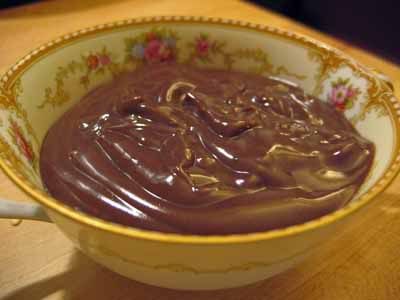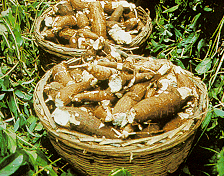So what the heck is British pudding anyway? What about rice pudding, isn't that really rice in lots of sticky goo? And what about bread pudding? Isn't that secretly bread with something like syrup or honey all over it? And the final question: what is tapioca?
- First, let's start with American sweet pudding, the kind you know and love from the Jell-O pudding packets. If you make pudding from those packets, you mix the dried contents of the packet with milk. But what's really in those packets? What if you made pudding from scratch?
- Let's say you're going to make chocolate pudding (which is the very best kind). You might find lots of recipes, but basically they would all combine milk, eggs, chocolate, and sugar. First you'd warm the milk and then add the other stuff and beat it all together and cool. There's your pudding.
- Technically, the definition of pudding in American terms is "a sweet cooked dessert with a smooth creamy texture, typically consisting of flour, milk, eggs, and flavoring."

The master of puddings.
(Photo from some guy's confusing My Space page)
- When the British use the word "pudding" they can be using it to describe lots of things. Which explains why I was confused. Sometimes they use "pudding" to mean any kind of dessert, or the dessert course in a multiple course meal.
- Or, sometimes the British use "pudding" to refer to what is now classified as a meat pudding. Meat puddings are actually the earliest known forms of pudding. The sweet puddings didn't come into being until the 17th century.
- Meat puddings, or most old-school British puddings, are either a mixture of flour and suet, which is the hard fat found around the kidneys and loins of cows or sheep, which is then steamed. Meat puddings can also be the intestines of a sheep or a pig stuffed with meat, oatmeal, and spices, and then boiled.
- While you're all shouting "Ew!" here's another tidbit for you. The word pudding comes from the Latin word botellus, which means "sausage or small intestine."

This is a steak and kidney pudding. You cook this in a little basin and when it's done, you upend the basin, giving the pudding its molded shape.
(Photo and recipe from Cookstr)
- Rice pudding is one of the sweet puddings, and it's not the smooth and creamy mixture we generally think of when we talk about pudding. Still, for many people, it's one of those comfort foods because it's gooey and warm and simple.
- Rice pudding is generally made with rice, milk, and sugar, and then you can add flavorings like lemon or nutmeg, and depending on how thick you want it to be, you could add butter or shortening or some other form of fat. Lots of people also add raisins.

Here's a peaches and cinnamon rice pudding, enjoying the view out the window
(Photo from favorite brand name recipes)
- Bread pudding is one of those inventions designed to get the most use out of a staple item. In this case, you soften and sweeten up stale bread.
- In this variant, you start with bread cut into cubes, then add your good friends sugar, eggs, milk, and butter. From there, you can add whatever flavors you like, such as lemon or nutmeg or cinnamon, and dried fruits, or more exotic things like pineapple or applesauce. Then sometimes people top it with whipped cream or syrup.

A pan of Mom's Bread Pudding
(Photo from RonzCooking)
- Like rice pudding, tapioca pudding uses a starchy grainy thing, in this case tapioca, and adds the milk and sugar and eggs to it. But what are those little translucent knobby things we call tapioca?
- Tapioca is the hard white grain taken from the root of the cassava plant.
- Cassava plants are woody shrubs that grow in tropical places like Africa and Brazil and Indonesia. They are harvested for the starch in the roots, and that starch is then processed. Sometimes the starch gets milled to make flour, and sometimes it is combined with water in order to extract tapioca pearls.

These are cassava roots harvested in Guyana
(Photo from the Eden Project)

A fancy tapioca pudding, with the tapioca pearls plainly visible
- Finally, those other gooey things like custards and creme brulee can also be classified as types of pudding.
Sources
Love to Know Recipes, Pudding Recipes, Rice Pudding Recipes, Bread Pudding Recipes
OneLook, pudding, suet, tapioca, cassava
Encarta, Dictionary, pudding
Compact Oxford English Dictionary, pudding
Purdue University Center for New Crops & Plant Products, Cassava
No comments:
Post a Comment
If you're a spammer, there's no point posting a comment. It will automatically get filtered out or deleted. Comments from real people, however, are always very welcome!